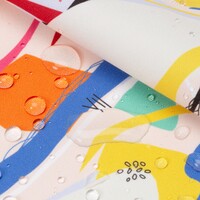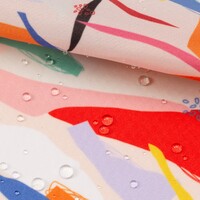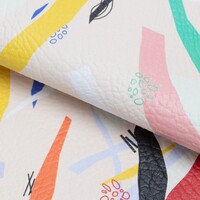Related:
Back to Site Stores ({{popupVm.storeTotalCount}})
Artists ({{popupVm.artistTotalCount}})
Have your photos or design printed on our collection of custom outdoor fabric. Find waterproof fabric for...
Read MoreShips In 1 - 2 days
Delivery: $12.95
Handmade
Which do you need for your custom outdoor fabric: waterproof or water-resistant?
Browse our range of outdoor fabrics.
Medium weight, stiff and non-stretch with a shiny finish - waterproof
100% polyester
Medium weight, smooth and non-stretch with a matte finish - water resistant
100% polyester
Medium weight, smooth and non-stretch with a matte finish - waterproof
100% polyester
Light weight, stiff and non-stretch with a matte finish - waterproof
100% polyester
Light weight, smooth and non-stretch with a matte finish - waterproof
100% polyester
Heavy weight, stiff and non-stretch with a matte finish - waterproof
100% polyester
Heavy weight, stiff and non-stretch, with a matte finish - waterproof
100% cotton
Heavy weight, soft and stretchy with a matte finish - water resistant
85% PVC 15% Polyester
Durable "leather" stamp effect leatherette. 30k Martindale rub test for durability. Waterproof (BS3424.5A)
90% pvc, 5% polyester, 5% cotton
Mid-weight fabric, knitted outdoor sports jersey that is quick-dry and breathable.
100% polyester
Stiff, Matte, Opaque, Woven, Poly. Heavier Weight Canvas. Use: bags, sails, heavy canvas, upholstery, wall art.
100% polyester
Heavy weight, rustic plain weave canvas. Hard wearing, Sailor's canvas. Uses: soft furnishings, bags, cushions, home textiles. Softens with washing. Edges will fray. Chunky weave, so fine detail not recommend.
100% polyester
Care instructions
Wash at 30°C / 86°F, low tumble dry heat, hang to dry, do not wring, low heat iron.




Outdoor fabric is simply fabric that is recommended for use outdoors. You would expect these to be waterproof fabrics, but not all of them are. Some of these fabrics are simply water resistant, so they tend to be lighter and softer, and are more suited for use making garments. Waterproof fabrics tend to be stiffer, and are great for outdoor furniture and for things like cushions for outdoor seating.
Waterproof fabrics fall into one of two categories: they are either hydrophobic, which means water-fearing, or hydrophilic, which means water loving. Hydrophobic fabrics are waterproof, however they are still permeable by steam. They have small pores which water cannot go through, however because steam particles are so much smaller than water, they can still pass through. Hydrophilic moves water using chemical diffusion. The fabric is negatively charged, and the positively charged water molecule is attracted through the gaps between the molecules of the fabric. This pushes the water through the gaps until the water vapor passes all the way through. Either way, you can expect your printed outdoor fabric to keep dry.
There are two different methods that we use to make your printed outdoor fabric, including dye sublimation and pigment printing. Both printing methods bond your design to your custom outdoor fabric. Pigment printing is localized printing. this method applies the dyes directly to specific parts of the fabric, building up the colors and design. Dye sublimation is done in two steps; first, your design is printed onto a transfer sheet, and then using heat, your personalized design is permanently bonded to your custom outdoor fabric.
Whether you have created a custom outdoor fabric for furniture or for garments, you'll have a choice of edge finishing options. You will be offered a choice of two different hems (overlocked or baby hem) in a choice of two different thread colors (black or white), or the option to have your fabric sent "as is" with a white border, or "cut on the line" with all the white edges removed.
If you are opting to have your fabric hemmed, please make sure that you allow for the hem in your fabric measurements.
All of our fabrics are printed at 200dpi. This works for us as it combines a great quality as well as a good file weight. In order to avoid resizing and interpolation, we recommend that you scale your image to 100% at 200dpi. Our design interface works with a traffic light system that acts as a quality marker for your designs. This will show you whether the resolution is too low for printing. When you re-upload your design with a highest resolution, the traffic lights will change color, showing you're good to go. A message will pop up alongside the traffic lights to let you know if the resolution is too low or if you have a good quality image.
Your uploaded design will automatically be scaled to fit the size of fabric you've chosen. You can change the dimensions of your fabric by amending the measurements on the ‘Product Options’ tab, under ‘Print Size’. To see how this fits with the dimensions of your image/design, you can refer to the ‘Images & Text Tools’ tab under 'Quality Information'. Here, you will be able to edit the dimensions of the image.
We always recommend using an RGB color space when you upload your images. More specifically, we suggest using the sRGB image profile, to achieve best color results. This will need to be done in your editing software; choose RGB as the working space, and assign the image profile as sRGB (full name sRGB IEC61966-2.1)
There is no length limit for most of our fabrics. Our preview design window is set up to displaying a maximum of 10m (32.8 ft) to help you visualize the print, but that doesn't mean this is the print limit. If you'd like to order more, you can increase the quantity (x2 for 20m or x4 for 40m for example) and order as much as you'd like. Larger volumes will receive an automatic discount too. While the fabric length is nothing to worry about, each individual fabric will have a maximum width side: These can be found on the fabric's page information or in the design interface.
Yes, that will help you when it comes to cutting or framing your printed fabric. We recommend always adding a little extra space for borders into your purchased fabric size. When we print your materials, or send out fabric samples, we typically trim squarely around the fabric, leaving approximately 5mm white space. Cutting neatly on the line has an additional fee.
Crocking is the term used to describe fading along the creases in a fabric. It typically can occur after constant washing or heavy use of digitally printed natural fabrics. Crocking can be minimized by hand washing your fabrics at a cooler temperature, rather than machine washing. If you want to make sure there's no chance of crocking, we'd suggest you use a poly fabric.
Yes, our organic fabrics don't have an additional coating like non-organic fabrics have, which means it absorbs the inks deep into its fiber and reducing the color strength slightly (this can be approximately -40%). If you would like a bolder, more vibrant color for your fabric, we would suggest using a non-organic fabric.
Unfortunately not; all of our fabrics have been tested meticulously to ensure we know exactly how to get the best results, and our facilities cater perfectly to them. If you are set on a fabric we don't offer, we can offer custom printed sublimation paper to order which will allow you to heat press your designs onto your own fabrics.
If your design is simple and less intricate, a JPEG will be absolutely fine. However, if you have created a design with multi-colored detailing, we would recommend saving your design in a TIFF format.
Similar to other fabric printing processes, shrinkage can occur. The amount of shrinkage will depend on the fabric, but as a general rule of thumb, please allow for 2-8% shrinkage when working out your measurements. Shrinkage is not an exact science, and the amount of shrinkage will vary from print run to print run. We'd always suggest order a little more than you need for your project.
Many of the fabrics we offer are semi-transparent, so printing on both sides of the fabric is not a service we offer.
At the moment, all of our fabric labels are printed on satin fabric. For now, we believe this is the best choice, but will potentially introduce other options in the future. All labels are cut to the same label format. If you would like to choose a different fabric and format for your labels, you could always order a sheet of the fabric of your choice to create labels yourself.
Our fabrics are printed with water-based inks as environmental consciousness is always front of our minds. Water-based inks include no chemicals or solvents, and our printing process uses heat to fix colors and patterns into place to avoid excess or contaminated water returning into the water system (this is something that can occur through steaming). All printing, fulfilment and production is done in our one facility, and rather than rolling the fabrics or sending them in a tube, you will receive your material folded up. This amounts to 150 tubes saved a week, as well as much more space on the delivery van for more orders. (For delicate fabrics we ensure to package appropriately).
Although very rare, there could be a slight color difference from one print run to another. This is a normal part of the printing process, however we are always working to improve our color profiles. It is unlikely that the difference in print runs will be hugely different (for example, it's unlikely your orange is suddenly going to be red). The likelihood of color variations can be intensified fabric to fabric due to materials having different grains and textures; natural fabrics typically have more muted color tones, while poly alternatives have a bolder hue. This is because the construction of the material is different, and the printing method has to be altered slightly for more delicate, natural textiles.
Our full cut & sew service at Bags of Love can be used to your full advantage. We even offer hemming for your fabrics at a small additional cost. Our hems are created with a one or two cold hem that typically uses around 5 to 20mm of fabric (depending on the thickness of your chosen material). Please bare this in mind when you are ordering your printed fabric with hems: If you would like your finished piece to be 40" x 40", change your dimensions to 41" instead to allow space for your hems (you will also need to include additional for potential shrinkage). The thicker the fabric, the bigger the hem will be. Your printed fabric will be hemmed with either Black or White thread. If you are ordering a lightly woven material or a printed silk, you will find that one hem will be straight, while the other slightly rippled. The hemming material allowances are as follows and you need to make your print bigger to accommodate the hem:
For further information about our fabrics see our FAQs.
Please note: As everything we provide is handmade to order, you may find a slight variance in the sizes.
















